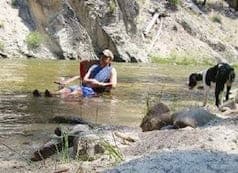
Curated with aloha by
Ted Mooney, P.E. RET

The authoritative public forum
for Metal Finishing 1989-2025

-----
Increasing Type III (Hardcoat) Anodizing Capacity
December 2, 2018
Q. I need to know what size Rectifier to get to Anodize (class III ) on parts about 1/8" thick by 12" long. Also on a very small piece of aluminum I saw somebody use a 6 Volt battery so is that even possible?
Thanks in advance.
Student - APOPKA
December 2018
(to help readers better understand the Q&A's)
Readers can see our Intro to Anodizing if they are slightly lost :-)
A. Hi Michael. Type 3 anodizing requires more voltage and more amperage than conventional (Type 2) anodizing. You are going to need 24 amps/ft2 and at least 24 volts even for "quasi" type 3 (48V, 75V, and 90V rectifiers are not unusual for Type 3 anodizing, depending on the alloy).
You can put aluminum into a sulfuric acid anodizing bath and only apply 6 volts, and some amount of aluminum will be converted to aluminum oxides, but the result will not be even a realistic type 2 anodized layer, let alone type 3.
Regards,

Ted Mooney, P.E. RET
Striving to live Aloha
finishing.com - Pine Beach, New Jersey
⇩ Related postings, oldest first ⇩
Q. Our company manufactures aluminum sheet metal products that we also finish with type III anodizing at our facility. We are considering increasing our tank sizes so we can increase our product capacity from 60 sq ft per rack of product to 100 sq ft rack of product. We know we will have to increase our rectifier size to 3000 amps and probably increase our cooling capacity, but I'm curious are there concerns with anodizing type III product at 2500-3000 amps, in a high production facility? Thanks in advance.
Scott Frazier- Spokane Valley, Washington
January 20, 2016
Treatment &
Finishing of
Aluminium and
Its Alloys"
by Wernick, Pinner
& Sheasby

(note: this book is two volumes)
on eBay or
AbeBooks
or Amazon
(affil links)
A. Hi Scott. There should be nothing prohibitive about bigger tanks and racks and rectifiers and cooling systems, but you haven't told us too much about your production line yet...
So we appended your inquiry to an earlier thread to suggest the possibility of adding additional hard coat cells rather than making everything bigger -- the principal being that if you have only one hard coat cell, the rest of your tanks are empty most of the time, which probably isn't the most economical use of resources. Good luck.
Regards,

Ted Mooney, P.E. RET
Striving to live Aloha
finishing.com - Pine Beach, New Jersey
January 2016
Q. Sorry for the lack of information. Our line has five type III cells that we keep constantly full.
Our load sizes vary depending on the size and shape of the product. We can type III anodize, 3003 aluminum, up to 2400 sq ft in an 8 hour shift. We are looking at purchasing a brand new line with larger tanks. Keeping the tanks full won't be a problem. Our racking spines are titanium with aluminum clips holding the product on. Our process is as basic as it gets. I have no knowledge anodizing type III above 1300 amps. I concerned with the higher amperage, what changes in process and racking we need to be aware of. Thanks
- Spokane Valley, Washington USA
January 20, 2016
A. As long as your current densities to your parts remain the same, and the new tanks/chilling system are properly designed/sized, there should be no problem at all with increasing your capacity as you describe it.
Going with larger tanks, you'll want to make sure your agitation system is designed so that you have no dead spots, and that the surface area of your cathodes are increased as well.

Marc Green
anodizer - Boise, Idaho
January 26, 2016

Aluminum How-To
"Chromating - Anodizing - Hardcoating"
by Robert Probert
Also available in Spanish
You'll love this book. Finishing.com has sold almost a thousand copies without a single return request :-)
A. Hi. I think Mark is right on, that the thing you need to double check is your agitation & cooling. 3000 Amps at hardcoating voltage is a lot of Watts, and you need to keep every point on every part at about 32 °F despite it.
Regards,

Ted Mooney, P.E. RET
Striving to live Aloha
finishing.com - Pine Beach, New Jersey
January 2016
Q. Thanks Mark and Ted! Thanks for mentioning the agitation as we have battled that for some time. We have both educators (90 gpm) and air sparging in our current system. When we run twenty-four hours, 5 days a week, we learned we need to turn down the air sparging in the type III tanks due to oxygen build up in the sulfuric. When the O2 builds ups, it slows down the anodizing time by 25%. Is there a way to actually measure the amount of oxygen in the acid? Thanks again for your help.
Scott Frazier [returning]- Spokane Valley, Washington USA
January 26, 2016
A. Hi. I've personally never heard of such a phenomena and would suggest that you demand strong evidence before accepting it :-)
Regards,

Ted Mooney, P.E. RET
Striving to live Aloha
finishing.com - Pine Beach, New Jersey
Q, A, or Comment on THIS thread -or- Start a NEW Thread